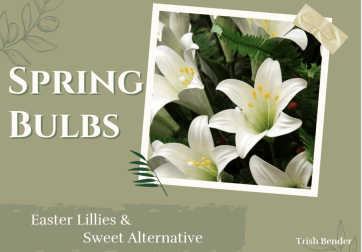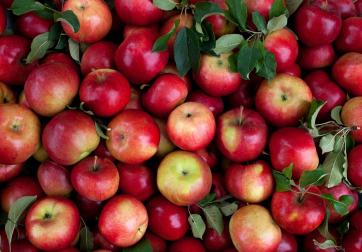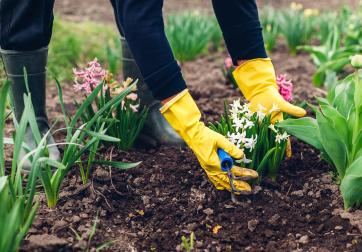Twenty-eight years ago, we bought a couple of wooded acres in southwest Missouri and built a home that is on a rocky bluff. The goal was to turn this property into terraced beds that attracted birds and beneficial insects. We did not want to have a lawn to mow. That was the idyllic dream, but it took a while for reality to sink in that as we aged, we would need to amend our original garden plans. My husband built the terraces in his spare time. It took many years to build and taking care of the beds was becoming a time-consuming monster that we have been trying to tame. I am a self-taught gardener and I have made many a plant choice mistake. What looks good in a friend’s garden or at a nursery can become the bane of my life (i.e., invasive).
The land was typical of the Ozarks; very rocky, little topsoil, and wild. We had a plethora of native trees, black oak, Osage-orange, shagbark hickory, black cherry, ash, persimmon, redbuds, cedar, sycamores, and walnut trees. Our first terraces were around many of these trees along with several walnut trees. It was dark, dry shade and the black walnut trees produce a chemical called juglone, which occurs naturally in all parts of the tree. This is leached into the soil with the highest concentration of juglone in the soil directly under the tree’s canopy. It was a gardener’s nightmare to find plants that could survive these conditions.
My husband and I dug up the limestone rocks with our pickaxes and my trusty Pickmatic. We amended the soil with fresh dirt, compost, and added wood mulch to keep the weeds down. It was my job to find the plants and shrubs that could survive these conditions. We spoke to nursery men and women selling their plants at the local farmers’ market, and I read article after article of the toxicity of walnut trees with some ideas of plants that might survive. We annually added wood mulch to the woodland beds to make them neater, suppress weeds, and retain moisture in the soil. This may be helping the perennials to survive year and year by suppressing the juglone that comes from the walnut trees.
It took a lot of experimentation and losing many plants, but I did discover plants that will survive each year. I came up with a list, albeit not an extremely long list, of perennials and annuals that will exist under walnut trees. I do need to confess that my original objective was to remove all of those walnut trees, and we did remove a few, but we share our property with a lot of wildlife, and the walnuts help some survive the winter even if those trees created a lot of extra garden work.
What survives? Hostas and ferns. The bigger the better to stand out in the shade. The hostas do look their best in late spring and early summer. The heat in July and August does cause some leaf burning for hostas on the perimeter of the terraces where the sunlight pierces through the canopy of leaves. Also, the trees are sucking the moisture out of the beds. I have carried many water cans of rainwater that we capture from our metal roof, however, sometimes we do succumb to using a sprinkler to keep our plants going until the late summer rains come.
Mayapples are native to our property and do well. Boxwoods will survive, but the variegated boxwoods may only last a few years before they give up from either the toxins or possibly vying for the same rainwater that the larger tree roots greedily steal.
Brunnera thrives and actually multiplies. I prefer the variegated type since the leaves provide more visual interest than the plain Jane all green brunnera. However, the plain Jane brunnera as a backdrop makes the variegated ones standout.
Liriope, lamium, and wild ginger make great ground covers – they thrive and spread. The deer trim back the liriope every winter (they ignore the liriope during most of the year but do become four-legged weed whackers to get rid of the old foliage and allow new to come up in the spring).
Celandine poppies provide bright yellow flowers that are welcomed to give “light” in what can be a dark garden. They will multiply once established and then become invasive. I have become quite a mercenary with a spade as my weapon to thin them out.
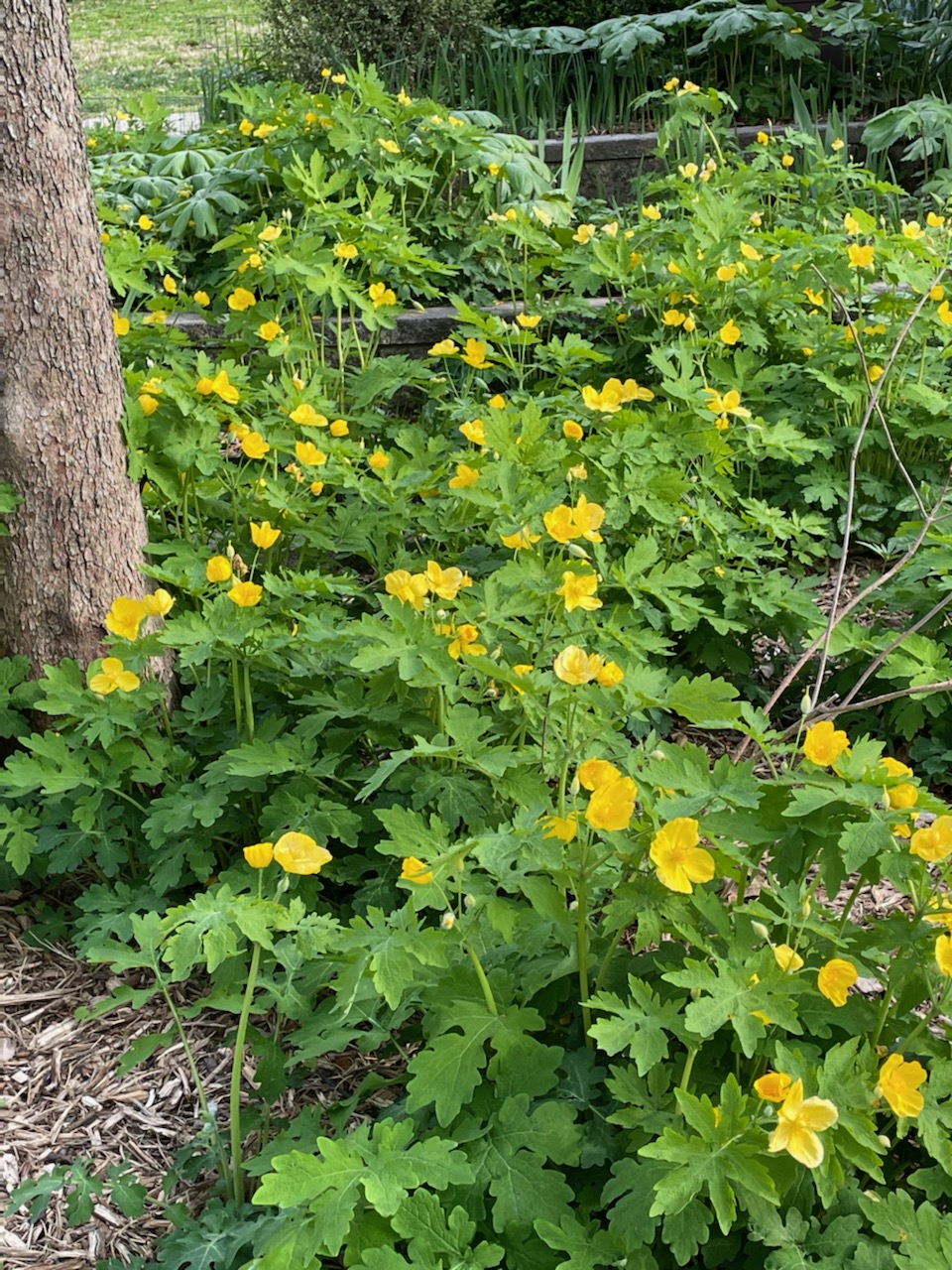
Jacob’s ladder, Virginia bluebells, perennial geraniums (cranesbill), and heuchera come back without fail every spring, but I find that they are not as reproductive as celandine poppies, brunnera, and wild ginger. The lamium was probably a mistake to plant; it has thrived too well and suckers under the soil, so it is super difficult to dig it all out. But I just love the snapdragon type flower that it produces. I guess that is why I have not gone after it with the same perseverance as I have with the celandine poppies. Tall phlox and dwarf Oriental lilies come back each year (they are on the periphery of my woodland beds and get a little sun).
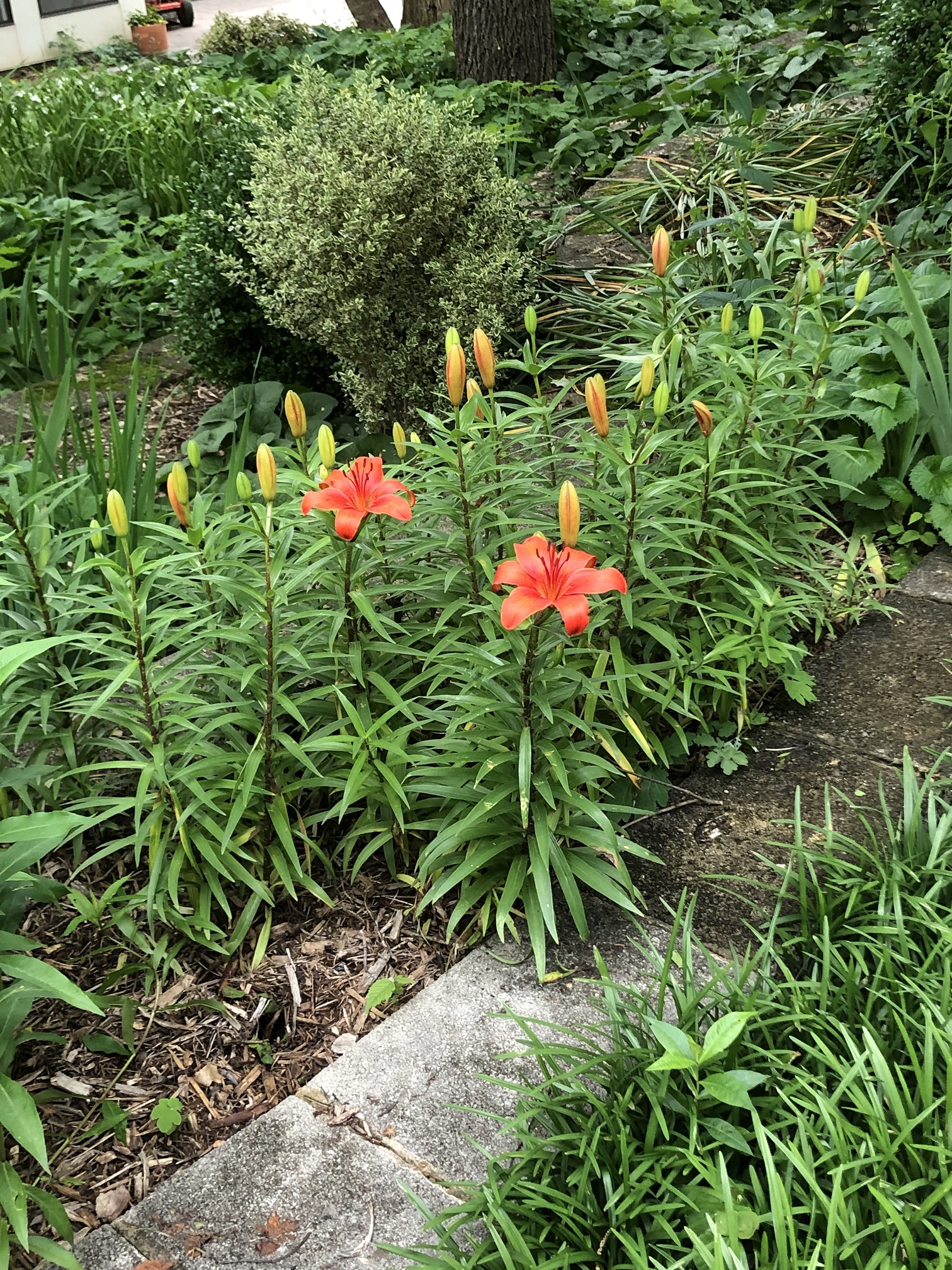
I am surprised that about a dozen or so Darwin hybrid tulips come up every year. We all know they are to be treated as annuals, but I must have gotten lucky with these tulips. The grape hyacinth may have had a better presence in this bed, but the deer seem to keep them in check before I can spray everything with a deer repellant.
I have a clump of spiderwort that gets bigger with each year; another invasive plant but the juglone must keep it from going crazy. Caladiums, coleus, and impatiens are annuals that survive, plus they add much needed color to break up the many shades of green with the perennials.
Gardening is always a case of experimentation. Gardening under walnut trees is a work in progress and a learning experience. What I have learned is that if the plant does not survive or does not work, dig it up and find a new spot for it, give it away, or just compost it if it turns out to be too aggressive. Some plants may need to be shipped to the trash or burned to safely dispose of them. I hope you can benefit from my experiences with walnut trees; it is possible to grow annuals and perennials under these types of trees.
National Garden Clubs, Inc. is a 501(c)(3) organization that aims to promote the love of gardening, floral design, and civic and environmental responsibility. There is a local club near you, click here to find one and join. Subscribe to the NGC’s blog by entering your e-mail here. You will receive an e-mail when there is a new blog article on the NGC website. You do not have to be an NGC member to subscribe.
7 Comments
Second VP
Very well written, Jossette. I knew planting under a walnut tree was risky. You have proven the point not to dispair many exciting plants will grow.
tri-consultant
I enjoyed reading about your yard adventure and like your writing style--Right to the point! You are lucky to have a gardening partner. Stay healthy and BEE well.
supervisor/gardener/Judge
what a nice article Josette---having lived in California amongst Walnut trees, and hazelnut trees, I found that some of the invasives do not in fact care where they live or spread. I always liked the English Walnuts in the yard because of their grey bark and look. However, I have found that the Almond nut pollen (dust) causes a severe allergic reaction for some of us, while the English Walnut is not as bad. So, if you stay out of the yard when the wind is blowing, your allergies are less. Take care.
President, Louisiana Garden Club Federation
Thank you for writing your article Josette. I am glad to know I am not the only gardener that has to learn by trial and error. Every garden is different and the books don't help as much as we would like. Mostly, it is trial and error.
Post Author
Second VP, Donna Rouch:
Donna, thank you for your comments. It is definitely experimenting with many gardening situations; part of the challenge and fun to figure it out.
Tri consultant :
Chris, it has been an adventure taking untamed land and semi-taming a part of it. However, Mother Nature always gives me a reality check.
Supervisor/Gardener/Judge:
Madeline, I appreciate so much what you encountered in California with hazelnut and almond trees. We deal with cedar tree pollen in Spring which can almost look like smoke coming off the cedar trees.
President , Louisiana Garden Club:
Roxanne Champagne, I agree; I researched what would grow under walnut trees, talked to experienced gardeners, but found that trial and error was my only recourse. I did find a nurseryman that clued me in that fresh mulch may be the secret to dispel some of the juglone.
Green Thumb GC Red Lion Area VP
Well written and informative. Two successful plants under my English walnut trees are hellebores and sweet woodruff if you like to give them a try.
Brother to the author
Unlike Josette's other brother, who reads little unless there are numerous pictures, I read the article with both interest and awe. It was without surprise that I did learn something from her in-depth commentary. I knew that plant life, including grass, did not survive the immediate area of certain trees, including walnut trees. Now, I know why. Thanks, Josette, for sharing some more of your invaluable knowledge.

 Board Member Login
Board Member Login Our Store
Our Store Blog
Blog



